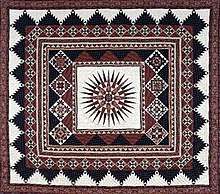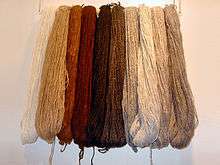Patchwork
Patchwork or "pieced work" is a form of needlework that involves sewing together pieces of fabric into a larger design. The larger design is usually based on repeating patterns built up with different fabric shapes (which can be different colors). These shapes are carefully measured and cut, basic geometric shapes making them easy to piece together.


Uses

Patchwork is most often used to make quilts, but it can also be used to make bags, wall-hangings, warm jackets, cushion covers, skirts, waistcoats and other items of clothing. Some textile artists work with patchwork, often combining it with embroidery and other forms of stitchery.
When used to make a quilt, this larger patchwork or pieced design becomes the "top" of a three-layered quilt, the middle layer being the batting and the bottom layer the backing. To keep the batting from shifting, a patchwork or pieced quilt is often quilted by hand or machine using a running stitch in order to outline the individual shapes that make up the pieced top, or the quilting stitches may be random or highly ordered overall patterns that contrast with the patchwork composition.
History

Evidence of patchwork—piecing small pieces of fabric together to create a larger piece and quilting layers of textile fabrics together—has been found throughout history. The earliest examples have been located in Egyptian tombs and also in early age of China about 5000 years ago. Further finds have been dated from the early Middle Ages, where layers of quilted fabric were used in the construction of armor—this kept the soldiers warm and protected. Japanese armor was made in a similar fashion.[1]
Using this technique, quilts began to appear in households of the 11th to 13th centuries.[2] As the European climate became colder around this time, the incidence of the use of bed quilts rose, and so developed the practice of embellishing a simple cloth through the creation of pattern and design, alongside the development of decorative quilting. The tradition of making quilts in this fashion was taken to America by the Pilgrims.[3]
United States
Patchwork enjoyed a widespread revival during the Great Depression as a way to recycle worn clothing into warm quilts. Even very small and worn pieces of material are suitable for use in patchwork, although crafters today more often use new 100% cotton fabrics as the basis for their designs. In the US, patchwork declined after World War II but was again revived during the American bicentennial. In the past, hand quilting was often done in a group around a frame. Instead of quilting, the layers are sometimes tied together at regular intervals with pieces of yarn, a practice known as tying or knotting, and which produces a "comforter".[4]
Popularity
The 2003 Quilting in America survey estimated that the total value of the American quilting industry was $2.7 billion.[5] International quilting exhibitions attract thousands of visitors, while countless smaller exhibitions are held every weekend in local regions. Active cyber-quilting communities abound on the web; books and magazines on the subject are published in the hundreds every year; and there are many active local quilting guilds and shops in different countries. "Quilt Art" is established as a legitimate artistic medium, with quilted works of art selling for thousands of dollars to corporate buyers and galleries. Quilt historians and quilt appraisers are re-evaluating the heritage of traditional quilting and antique quilts, while superb examples of antique quilts are purchased for large sums by collectors and museums. The American Quilt Study Group is active in promotion of research on the history of quilting.
Asia
In Indian stitching blanket using different small pieces of cloth is an art. It is popularly known as Kaudhi in Karnataka. Such blankets are given as gifts to newborn babies in some parts of Karnataka. Lambani tribes wear skirts with such art.
Patchwork is also done in various parts of Pakistan, especially in the Sindh region, where they call it ralli.[6] Pakistani ralli quilts are famous all over the subcontinent even in the west. These quilts are a part of their tradition and are made by women. Now these are gaining international recognition even though they have been making them for thousands of years.
Structure
There are three traditional structures used to construct a patchwork or pieced composition: 1) the block, 2) overall, and 3) strip piecing. Traditional patchwork has identifying names based on the arrangement of colors and shapes.
Blocks
Patchwork blocks are pieced squares[7] made up of colored shapes that repeat specific shapes to create patterns within the square or block of, say, light and dark or contrasting colors (motif). The blocks can all repeat the same pattern, or blocks can have several different patterns. The patchwork blocks are typically around 8–10 in2 (52–65 cm2). They are sewn together in stacked rows to make a larger composition. Often strips of contrasting fabric forming a lattice separate the patchwork blocks from each other. Some common patchwork block names are Log Cabin, Drunkard's Path, Bear's Paw, Tulip, and Nine Patch.
A unique form of patchwork quilt is the crazy quilt. Crazy quilting was popular during the Victorian era (mid–late 19th century). The crazy quilt is made up of random shapes of luxurious fabric such as velvets, silks, and brocades and buttons, lace, and other embellishments left over from the gowns they had made for themselves. The patchwork pieces are stitched together forming "crazy" or non-repeat, asymmetric compositions. Fancy embroidery embellishes the seam lines between the individual, pieced shapes. The crazy quilt was a status symbol, as only well-to-do women had a staff to do all the household work, and had the time to sew their crazy quilt. Traditionally, the top was left without lining or batting. Many surviving crazy quilts still have the newspaper and other foundation papers used for piecing.
Overall
Overall patchwork designs are incrementally pieced geometric shapes stitched together to form a larger random or composed design. The colored shapes can be randomly pieced or follow a strict order to create a specific effect, e.g. value (light to dark) progressions, or checkerboard effects. Names such as Hit or Miss, Clamshell, back-stitch, needle weave, criss-cross, and Starburst identify some overall patchwork structures.
Round pieces formed by cutting a circle of fabric, gathering the edges with a running stitch and pulling them tightly shut are known as Suffolk puffs in the United Kingdom due to the Suffolk wool used to pad them. In the United States, the pieces are called yo-yos. The origin date of this type of piecework is unknown, but it was popular in the United States during the Great Depression and in the United Kingdom after World War II.[8][9] These round pieces can be joined with several stitches on the sides to connect other puffs together and form a coverlet or other items. Scrap pieces may be used, or colors may be coordinated into patterns.
Strip piecing
Strip piecing involves stitching together pieces of fabric in repeat patterns into long strips and then stitching the strips together lengthwise. The patchwork strips can be alternated with strips of contrasting colors. A typical strip patchwork quilt is the Four Patch pattern.
Forms

Specialised forms of patchwork include:
- Cathedral window
- Scrap piecework
- Foundation piecework or the closely related
- English paper piecing
- Seminole patchwork
- Hawaiian piecework (primarily applique)
- Stained glass window patchwork, used to simulate the effect of stained glass in church windows. Satin fabrics simulate the colored glass, and black bias binding tape simulates the lead.
References
- "Asian Art Museum | Conservation of Japanese Armor". www.asianart.org. Retrieved 2020-01-06.
- "Connecting Cultures Mobile Museum - Collection - US Hawaiian Quilt: "'Ulu" Design". www.connectingcultures.us. Retrieved 2017-07-12.
- Helen Page, The History of Patchwork and Quilting, 1999.
- Hand quilting
- Quilting in America 2003 edition
- Ralli quilt
- Quilting History
- "2004-1-B suffolk puffs table coverlets". The Quilt Association. Retrieved 2020-06-14.
- Whittle, Sarah (2013). The Needlecraft Style Directory. North America: Barron’s Educational Series, Inc. p. 79. ISBN 978-1-4380-0103-6.
Further reading
- Schnuppe von Gwinner (1988), The History of the Patchwork Quilt, ISBN 0-88740-136-8
- Eleanor Levie (2004), American Quiltmaking 1970–2000, ISBN 1-57432-843-3
- Celia Eddy (2005), Quilted Planet, ISBN 1-84533-009-9

